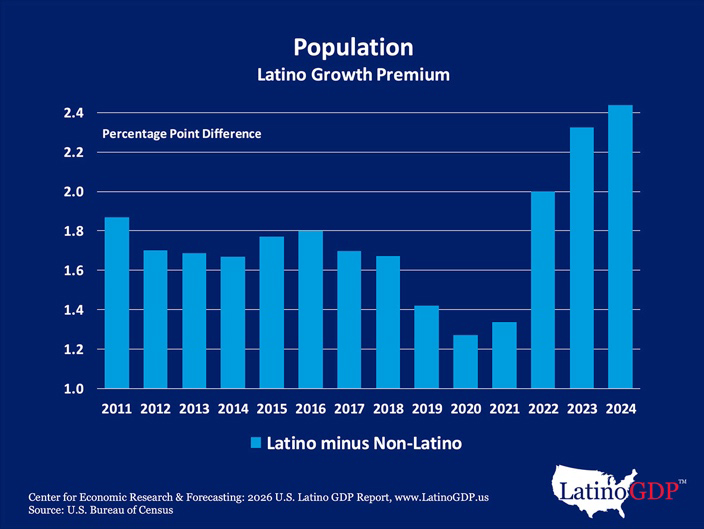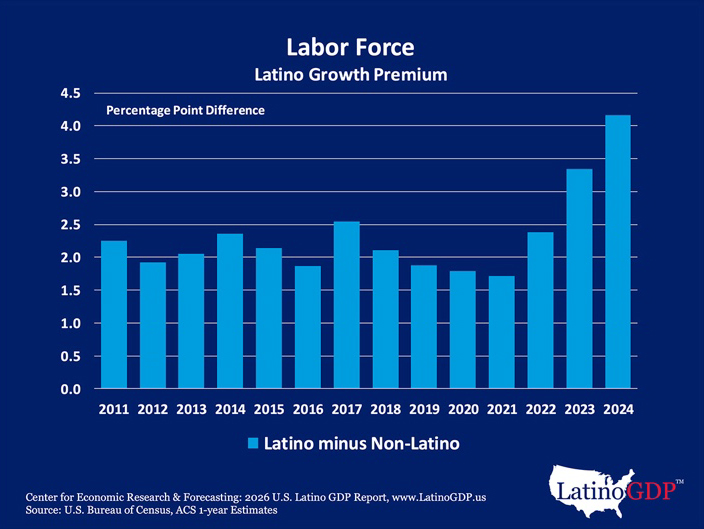Key takeaways
- The total U.S. Latino population in the United States is estimated to be over 68 million, with one out of every five people being Latino for the first time in history.
- The researchers found that the nation's Latino labor force grew 5.5% in 2024, to 35.1 million workers.
- The labor force participation rate for Latinos also reached an all-time high of 69% last year.
For the first time in history, one out of every five people in the U.S. is Latino, according to a new data analysis by the Latino GDP Project from UCLA and Cal Lutheran. Using 2024 data from the U.S. Census Bureau, which was released in June, researchers discovered an increase of 2 million persons in this demographic compared to the updated 2023 population estimates. The total U.S. Latino population is estimated to be more than 68 million, they found.
"In 1988, lacking the sophisticated data we now have, we projected that Latinos might grow to 58.8 million by now," said David Hayes-Bautista, distinguished professor of medicine at UCLA and coauthor of the report, "but obviously we were too conservative."

The population growth is even more striking when analyzed alongside the U.S. Census Bureau's recent American Community Survey, which showed the Latino labor force grew 5.5% last year, the single strongest growth recorded by the researchers, and 4.2 percentage points stronger than the non-Latino labor force. From 2010 to 2024, the Latino component of the U.S. labor force grew 7.2 times faster than the non-Latino labor force and now sits at 35.1 million workers.
"Time and time again, we find that hard work, self-sufficiency, optimism and perseverance are the characteristics that underly the strength and resilience of U.S. Latinos," said Matthew Fienup, executive director of the Center for Economic Research & Forecasting at Cal Lutheran.
The Latino labor force participation rate also reached an all-time high of 69%. The Latino labor force participation premium — the difference between Latino and non-Latino participation rates — hit a record of 6.2 percentage points in 2024.
"More people working harder leads to greater Latino GDP growth," Hayes-Bautista added. "These new data indicate that the U.S. Latino labor force is shattering records for economic vibrancy."

These findings build upon April's 2025 U.S. Latino GDP Report, which revealed that the U.S. Latino GDP hit $4.1 trillion, making it the world's fifth-largest GDP, larger than the entire economy of India. The nation's Latino GDP is also the single fastest-growing among major economies, growing faster than China's GDP since 2019.
The Latino GDP Project, a multi-disciplinary research initiative, provides in-depth and timely documentation of the economic powerhouse represented by U.S. Latinos. Eight consecutive annual reports demonstrate that the vitality of the overall U.S. economy is tied to the growth, labor and economic activity of U.S. Latinos.
"By supporting this population, we believe these same characteristics will continue to drive growth in the overall U.S. economy for years to come," Fineup said.
Additional findings:
- The population growth of Latinos is currently 5.8 times faster than the non-Latino population. This means that the difference between Latino and non-Latino one-year growth rates, known as the Latino population growth premium, reached a high of 2.4 percentage points in 2024.
- Latino natural population change (the number of births minus deaths) remained positive throughout the pandemic, despite Latinos suffering higher COVID-19-related mortality. From 2020 through 2024, the cumulative Latino natural population increase was 3.2 million, compared to a decline of 1.3 million for non-Latinos.
- The Latino labor force grew 5.5 % from 2023 to 2024, an explosion from the 3.8% growth of 2023 which, at the time, was the strongest on record.






